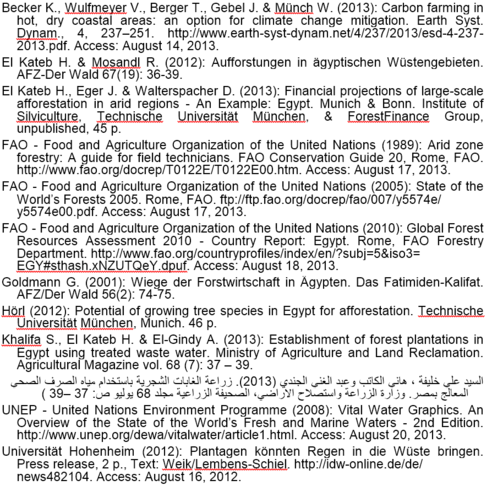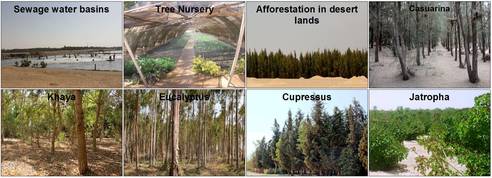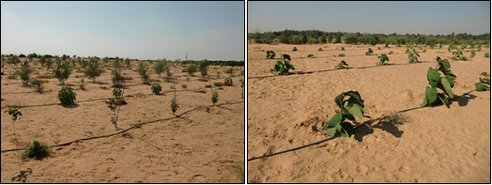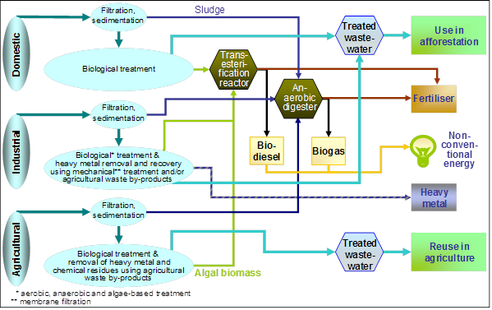

Introduction
Our world is currently facing many challenges that extend from environmental degradation to energy, food and water shortages for an ever-increasing world population. The cause of our problems is mainly man-made. Human beings are resource dependent, but most of our natural resources are finite and non-renewable. Many of the resources, such as minerals, develop very slowly throughout hundreds of millions of years. If resources are not used in a sustainable way they will be depleted, leaving future generations barren and empty handed. At present, human beings are inappropriately managing their resources by achieving a short-term benefit while causing pollution and degradation to the environment.
By utilising the appropriate knowledge and technology currently available to us, we can solve many of the problems the world is facing today through the proper use and use of potential of the available resources in a sustainable way. The following describes the use of available resources which have not yet been effectively utilised for afforestations in arid regions. Afforestation is the planting of trees on land formerly used for purposes other than forestry.
Use of available resources for afforestation in arid regions
Arid lands cover an area of nearly one third of the earth's land surface, where over one third of the world's population lives. According to the FAO (1989), arid zones include hyper-arid, arid, and semi-arid regions with 4.2%, 14.6%, and 12.2% of the total land area of the world, respectively. The largest two subtropical deserts are the Sahara (9.1 million km2) in Northern Africa and the Arabian Desert (2.3 million km2) in the Arabian Peninsula. Subtropical deserts offer plenty of unutilised lands. Subtropical deserts are characterised by low annual precipitation but, on the other hand, they provide possibilities for trees to grow all-year round and they receive sufficient sunlight, which is essential for the tree growth. Up to a certain extent, the more sunlight available for a tree, the higher the photosynthetic ability and thus the tree production.
Freshwater makes only about 2.5% of the global water resources and 97.5% are saltwater (UNEP, 2008). The usable proportion of freshwater sources accounts for less than 1% of total freshwater, i.e. only 0.01% of all water on Earth (UNEP, 2008). Insufficiency of water in many of the arid regions is a serious constraint for human welfare and economic development. Nevertheless, wherever people live, wastewater is generated from municipal, industrial and agricultural activities. Unutilised wastewater represents serious hazards for the human health and environment and in addition is a waste of valuable water resources. Wastewater from municipal activities or sewage water can be partially treated and then used in providing the required water to irrigate trees. Sewage water has high content of the primary plant nutrients "nitrogen" and "phosphorus", which are also essential for tree growth. Furthermore, sludge or solid waste remains after the wastewater treatment can be used for the production of renewable energy (e.g. biogas) and soil conditioner.
In summary, the potential of the available resources (unutilised desert lands, sunlight, sewage water and nutrients in sewage water) is efficiently used for the establishment of plantation forests in arid regions and, subsequently, the production of renewable resources (e.g., wood, woody-biomass or biofuel). In addition, the potential of the solid waste of the wastewater is also used for the production of renewable energy and fertiliser.
Benefits of afforestation in arid regions
Afforestation has many purposes depending on the establishment goals, whether for production of timber, biomass or biofuel crops, for carbon sequestration or for environmental motivation. Afforestation in arid regions has a multi-functional approach as new established plantations can be of considerable economical, ecological and social benefits such as the below:
- Decreasing pollution as growing trees absorb carbon dioxide from the atmosphere.
- Protection against desertification, sand dune fixation, erosion prevention, and coastal protection.
- Efficient use of the scarce water resources.
- Wood production and biofuel-crop production, as a renewable energy source.
- Human settlement protection from wind and sand. Food security for an increasing population through protection of arable and new reclaimed lands from wind and combating desertification. If cultivated areas (e.g., for food production) are protected by forest (greenbelt/windbreak), there will be a considerable reduction in environmental stresses (reducing plant damage by frost, sand deposit and insects, improving the efficiency of irrigation and fertilisation, conserve moisture in plants and soil) and improvement of the microclimate, thus, achieving higher yield of the protected crops.
- Creating new jobs and qualification opportunities. Establishing new forest-based and related industries, which will help in promoting employment and national economic development.
- Offering recreational opportunities for residents and tourists due to the attraction of forests in arid regions.
Forestry in Egypt
Egypt offers a great opportunity for large-scale afforestation due to the availability of sufficient sewage water and desert land. After basic treatment, sewage water can be efficiently used as a resource for the production of wood, woody biomass and biofuel crops and for carbon trading.
The cause of the non-existence of forest in Egypt is not only due to the climatic conditions and the scarcity of rainfalls, but also as a result of the urbanisation and the focus on food production for the rapid increasing population. Although the geographical area of Egypt is large, exceeding one million km2, desert land dominates over 96% of the total land area with little scattered shrub vegetation. Most of the country’s vegetation grows in the Nile delta and valley “the most extensive oasis worldwide”. The Nile Delta and Valley have a rich variety of tree species, of which some are indigenous and some exotic.
Over a thousand years ago during the Fatimids era, Egypt was the first country in the world which established a national forest organisation (Goldmann, 2001). At that time, usage of wood was well managed, mainly in the construction of ships. Thousands of ships with dimensions of 85m in length and 35m abeam were built. Today, less than 0.07% of the country’s land area is covered with trees. FAO (2010) estimated for 2009 a total area of 691 km2 with nearly 74 million standing trees in Egypt. The country has almost no natural forests: Only relic of nature woodlands on the slopes of Gebel Elba (Mountain Elba) in the south of the country and sparse, scattered mangroves along the red sea coast can be found. Forestry in Egypt is mainly based on artificial forests with most common species being Casuarina spp. and Eucalyptus spp. used as windbreaks.
According to FAO (2005), Egypt achieved a 3.3% annual rate of change in forest cover between 1990 and 2000, which was the highest annual increase among the African countries; over the same period the average annual rate of change for the whole African continent was -0.8%. This increase of the forest area was due to the establishment of the “National Programme for the Safe Use of Treated Sewage Water for Afforestation” in the early/mid 1990s. Within the framework of this programme, a pilot project (Figure 1) was conducted on over 4,000 hectares spread over the country to determine the success/failure of afforestation using basic-treated sewage water. The afforestation includes different species, i.e., Acacia (Acacia nilotica and Acacia saligna), Casuarina (Casuarina equisetifolia), Cupressus (Cupressus sempervirens), Eucalyptus (Eucalyptus camaldulensis), African Mahogany (Khaya senegalensis), Neem (Azadirachta indica), Pine (Pinus pinea), in addition to Jatropha (Jatropha curcas) and Jojoba (Simmondsia chinensis) as biofuel crops. The results of the pilot project clearly revealed that sewage water can be used for the establishment of new plantations in desert lands and showed high potential for afforestation of multipurpose species of socio-economic importance.
Development of sustainable forestry in desert lands of Egypt
Based on the results of the pilot project and upon a Memorandum of Understanding between the Egyptian Ministry of State for Environmental Affairs and the Institute of Silviculture at the Technische Universität München (TUM) in 2007, the Institute of Silviculture has proposed a concept for the Establishment of Plantation Forests and Development of Sustainable Forestry in Desert Lands of Egypt Using Sewage Water (Figure 2). The concept lays emphasis on the improvement of productivity, quality, technology, cost-effectiveness, and economic returns of the plantation forests. Therefore, an accompanying applied research was proposed with the main objective to develop a decision support system for the sustainable management of plantation forests in arid regions including wastewater management. The supporting scientific work is carried out by highly qualified German and Egyptian scientists including: The Institute of Silviculture, Technische Universität München (TUM); Department of Agricultural Engineering, Ain Shams University; Department of Forestry and Wood Technology, University of Alexandria; Institute of Hydraulic and Water Resources Engineering, TUM; Institute of Water Quality Control, TUM; Agriculture Research Centre, Ministry of Agriculture and Land Reclamation.
The Bavarian State Government in Germany has expressed support to the afforestation attempts in Egypt by providing technical assistance in the form of technology transfer and support in capacity building. Experts’ consultation was provided by the Bavarian State Ministry of Agriculture and Forestry and the Institute of Silviculture at the Technische Universität München.
In 2012, the German Academic Exchange Service (DAAD) provided funds to support the implementation of a part of the research activities, the assembling of forest-management knowledge at the Egyptian Universities, the optimisation of the afforestation programme, and in addition to strengthen research cooperation in forest and water resource management and scientific exchange through further partnerships between Germany and Egypt.
The media, whether Egyptian or German, has in many contributions reported on TV and newspapers positively about the afforestation project.
Achievements
The scientific team in collaboration with the Under-Secretariat for Afforestation and Environment of the Ministry of Agriculture and Land Reclamation could gain important scientific information and attain achievements towards the successful realisation of the afforestation in Egypt.
Hörl (2012) showed that the potential of forest trees growing in Egypt is high: 134 Forestry-relevant tree-species that are growing in only two parks in Cairo were found. El Kateb and Mosandl (2012) determined the yield of some tree species of the plantations forests in Egypt, which was high, and estimated that the volume achieved in Egypt is approximately attained 4.5 times earlier than in Germany, the leading country in Forestry in Europe. Khalifa, El Kateb & El-Gindy (2013) investigated the feasibility of the afforestation in Egypt using sewage water and concluded its environmental, social and economic feasibility. El Kateb, Eger & Walterspacher (2013) estimated an internal rate of return exceeding 12% by afforesting 1,000 ha of desert lands using 14 tree species that were selected on scientific basis by the German and Egyptian scientific team (Figure 3). The species are:
- Precious hardwood species: Gmelina or White Teak (Gmelina arborea), African Mahogany (Khaya senegalensis), Outeniqua yellowwood (Podocarpus falcatus), Teak (Tectona grandis)
- Hardwood species: Mangium or Black Wattle (Acacia mangium), Neem or Indian Lilac (Azadirachta indica), Lemon-scented gum (Corymbia citriodora), River Red Gum (Eucalyptus camaldulensis)
- Softwood species: Caribean Pine (Pinus caribbea var. hondurensis), Canary Island pine (Pinus canariensis)
- Biofuel crops: Jatropha (Jatropha curcas), Jojoba (Simmondsia chinensis)
- Windbreak species: Orange Wattle (Acacia saligna), and Casuarina (Casuarina equisetifolia).
Within the framework of the Egyptian-German collaboration, many workshops were conducted to deal with the proper treatment of wastewater. Emphasis was also laid on the allocation of the available wastewater, the proper use of the potential of the wastewater and on improving its treatment (Figure 4) to ensure the safety and quality of the treated wastewater before reuse.The Agriculture Faculties at the Egyptian Universities will integrate in their study curricula new study modules for higher agriculture education in plantation forest management and water resource management. Technische Universität München is providing support by conducting study courses, practical training and workshops in Egypt and Germany. A Forest Department will be soon established at the Faculty of Agriculture, Cairo University. The achievements have awakened the interest of international organisations. Forest Finance Group, Bonn/Germany, a leading organisation in Germany in forest investments and in the development and operation of sustainable forest products, is considerably supporting the development of the afforestation in Egypt in commercial application and forest carbon trading.
Large-scale afforestation in Egypt
Large-scale afforestation in arid regions supports innovative solutions to actual national (Egyptian) and global challenges, such as climate change, renewable energy, food security and management of resources. Afforestation is one of the most effective tools to carbon dioxide fixation. Forest products as wood and biomass are significant sources for renewable energy.
Egypt produces a huge volume of sewage water annually. 5.5 billion m3 of this sewage water, which equals 10% of Egypt’s fixed share of Nile water, is sufficient to afforest over 650,000 hectares of desert lands and store over 25 million tons of CO2 annually in the new plantation forests (El Kateb and Mosandl, 2012). Large-scale afforestation may stimulate cloud formation and may result in rainfall that the country urgently needs to expand its agricultural production areas (El Kateb and Mosandl, 2012). Their conclusion is supported by a press release of the University of Hohenheim (2012) and a recent study from Becker et al. (2013). Becker et al. (2013) suggest large-scale plantations of Jatropha curcas in hot, dry coastal areas to capture carbon dioxide from the atmosphere. The authors had conducted high-resolution simulations using an advanced land-surface–atmosphere model and concluded that large-scale plantations of Jatropha curcas (10,000 km2) could lead to a reduction in mean surface temperature and an onset or increase in rain and dew fall at a regional level.
To ensure sustainability and the ecological and economical success of the large-scale afforestation, emphasis is laid on the Political-Scientific-Economic Collaboration (Figure 5). This is achieved by a viable framework and optimal planning through the political, economic, and scientific environment, respectively, and by gathering the competences, experiences, possibilities and prospects of all the three spheres.
Private sector involvement
The Egyptian Government has expended considerable funds on the development of the infrastructure necessary for the safe use of treated sewage water for afforestation and will set the basis to facilitate the involvement of national and international organisations in order to encourage their investment activities.
References

Author
Hany El Kateb, Institute of Silviculture, Technische Universität München




